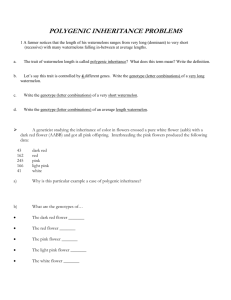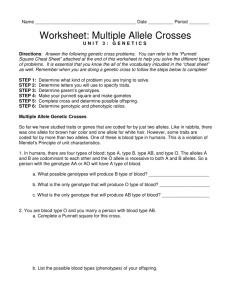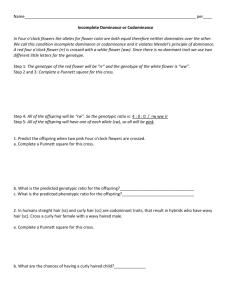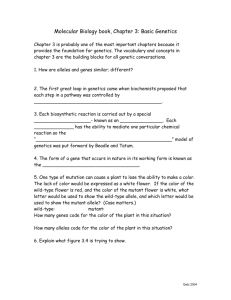Multiple Allele & Polygenic Inheritance Worksheet
advertisement
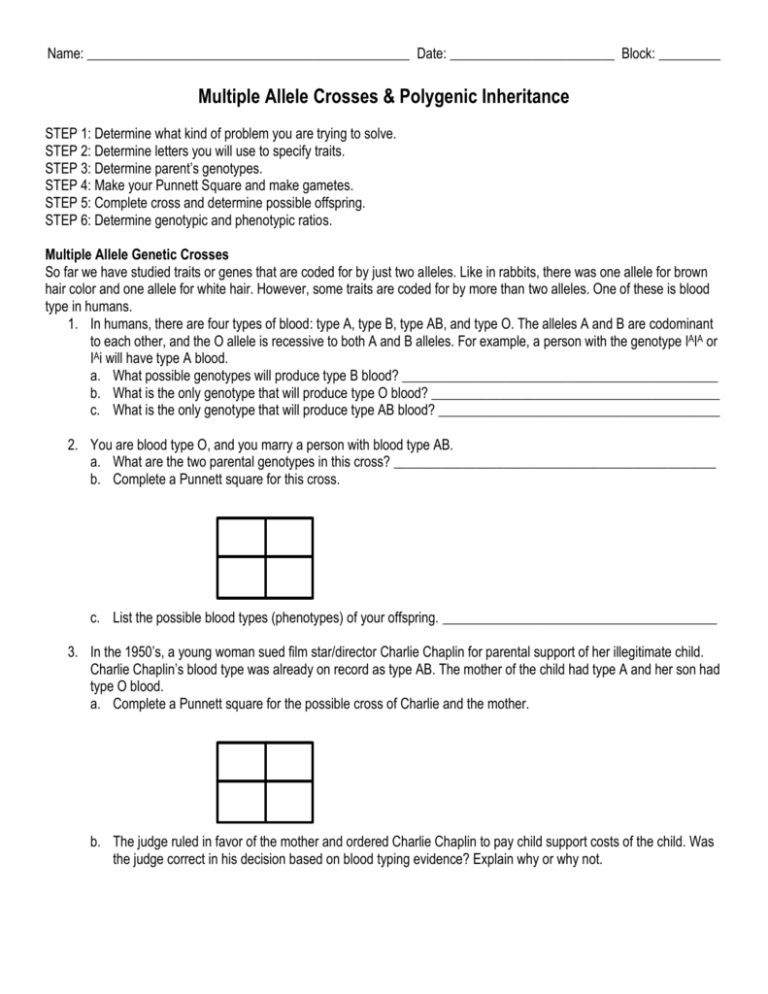
Name: _______________________________________________ Date: ________________________ Block: _________ Multiple Allele Crosses & Polygenic Inheritance STEP 1: Determine what kind of problem you are trying to solve. STEP 2: Determine letters you will use to specify traits. STEP 3: Determine parent’s genotypes. STEP 4: Make your Punnett Square and make gametes. STEP 5: Complete cross and determine possible offspring. STEP 6: Determine genotypic and phenotypic ratios. Multiple Allele Genetic Crosses So far we have studied traits or genes that are coded for by just two alleles. Like in rabbits, there was one allele for brown hair color and one allele for white hair. However, some traits are coded for by more than two alleles. One of these is blood type in humans. 1. In humans, there are four types of blood: type A, type B, type AB, and type O. The alleles A and B are codominant to each other, and the O allele is recessive to both A and B alleles. For example, a person with the genotype IAIA or IAi will have type A blood. a. What possible genotypes will produce type B blood? ______________________________________________ b. What is the only genotype that will produce type O blood? __________________________________________ c. What is the only genotype that will produce type AB blood? _________________________________________ 2. You are blood type O, and you marry a person with blood type AB. a. What are the two parental genotypes in this cross? _______________________________________________ b. Complete a Punnett square for this cross. c. List the possible blood types (phenotypes) of your offspring. ________________________________________ 3. In the 1950’s, a young woman sued film star/director Charlie Chaplin for parental support of her illegitimate child. Charlie Chaplin’s blood type was already on record as type AB. The mother of the child had type A and her son had type O blood. a. Complete a Punnett square for the possible cross of Charlie and the mother. b. The judge ruled in favor of the mother and ordered Charlie Chaplin to pay child support costs of the child. Was the judge correct in his decision based on blood typing evidence? Explain why or why not. 4. Suppose a newborn baby was accidentally mixed up in the hospital. In an effort to determine the parents of the baby, the blood types of the baby and two sets of parents were determined. Individual Baby Mrs. Brown Mr. Brown Mrs. Smith Mr. Smith Blood Type O B AB B B a. Draw Punnett squares for each couple. (If you need to do more than one square per couple, use the back side of this packet.) a. To which parents does the baby belong? Why? 5. Remember: Genotypes (IA IA) and (IA i) are phenotypically type A; genotypes (IB IB) and (IB i) are type B; genotype (IA IB) is type AB; genotype (i i) is type O blood. A man with blood type IA IA marries a woman with type AB blood. What are the genotypic and phenotypic ratios of the children? 6. A man with type B blood marries a woman with type A blood. They have the first child with blood type O. a. Complete a Punnett Square for this cross. b. What are the genotypes of the father and the mother? _____________________________________________ c. What is the genotype and phenotype of the baby? ________________________________________________ 7. A man with type O blood marries a woman with type AB blood. a. Complete a Punnett Square for this cross. b. What are the predicted genotypic ratios of their children? ___________________________________________ c. What are the predicted phenotypic ratios of their children? __________________________________________ Polygenic Inheritance 8. A geneticist studying the inheritance of color in flowers crossed a pure white flower (aabb) with a dark red flower (AABB) and got all pink offspring. Interbreeding the pink flowers produced the following data: Flower Color Dark Red Red Pink Light Pink White Offspring Produced 43 162 245 166 41 a. Why is this particular example a case of polygenic inheritance? b. What are the genotypes of… The dark red flower? _______ The red flower? _______ The pink flower? _______ The light pink flower? _______ The white flower? _______ c. Cross a red flower (AaBB) with a pink flower (AaBb). What are the expected phenotypic ratios of offspring? d. Cross a light pink flower (aaBb) with a pink flower (AaBb). What are the expected phenotypic ratios of offspring? 9. Human skin color is a good example of polygenic inheritance. Assume that three genes control skin color. The capital letter alleles (A, B and C) control dark pigmentation because more melanin is produced. The lower case alleles of these three genes (a, b & c) control light pigmentation because lower amounts of melanin are produced. A genotype with all capital genes (AABBCC) has the maximum amount of melanin and very dark skin. Another way to think about it is to imagine that each capital letter allele makes one unit of melanin…by that logic, a skin cell with the genotype AABBCC would make 6 units of melanin and be dark. A genotype with all lower case allele (aabbcc) has no capital letters, and would very light skin. Remember, each capital allele produces one unit of color, so that a wide range of intermediate skin colors are produced, depending on the number of capital alleles in the genotype. For example, a genotype with three capital alleles and three lower case alleles (AaBbCc) has a medium amount of melanin and an intermediate skin color. In the following cross (AABbCc x AaBbCC), how many kids would you expect to have 5 or more units of melanin? From Sieminski Biology





